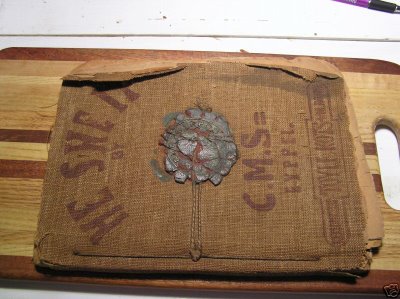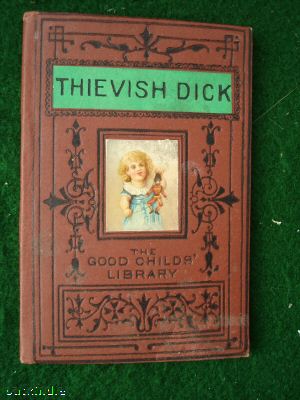Saturday, April 29, 2006
The Terror of Thomas Edison
I didn't notice at first last week when the Telegraph debuted an occasional series by John Gibbens on a book found while browsing in a secondhand bookshop -- it's a splendid idea for a column. He starts good and obscure with The Phoenix Suburb: A South London Social History by Alan Warwick, a local history published in 1973.
One of its tidbits features half of the musical team of Gilbert & Sullivan:
On a not entirely unrelated note, yesterday's Slate covered the explosion of lip-synch videos on YouTube, led by the inimitable Two Chinese Boys (aka the Back Dorm Boys), who have become a minor obsession in the Collins household. They have an English-language blog now, and this video pretty much makes them the comedy duo of the year.

...or trio, if you include the roommate who always sits obliviously playing Counter-Strike on his computer.
One of its tidbits features half of the musical team of Gilbert & Sullivan:
Another feature of modernity was cradled here, too. The first Edison recording machine to reach Britain was demonstrated in a Norwood villa, where Arthur Sullivan prophetically recorded this message: 'I am astonished and somewhat terrified at the results of this evening's experiments - astonished at the wonderful power you have developed, and terrified at the thought that so much hideous and bad music may be put on record for ever.'
On a not entirely unrelated note, yesterday's Slate covered the explosion of lip-synch videos on YouTube, led by the inimitable Two Chinese Boys (aka the Back Dorm Boys), who have become a minor obsession in the Collins household. They have an English-language blog now, and this video pretty much makes them the comedy duo of the year.

...or trio, if you include the roommate who always sits obliviously playing Counter-Strike on his computer.
Get Lost
Last Sunday's LA Times reviewed Stuart Kelly's new book The Book of Lost Books: An Incomplete History of All the Great Books You Will Never Read. They noted that the discovery of a "lost book" doesn't always raise a reputation:
Naturally, he is now called "the father of the sitcom."
Even worse is the story of Menander, adored by Plutarch and Julius Caesar, whose writings were presumed lost. All that was left was his reputation ("second only to Homer") until his work was rediscovered, in 1905. First, there was great excitement; then, critical revision. As Kelly puts it, "One of [his] favorite plots could be summarized as: 'Whoops! I raped someone last night,' which normally ended with perpetrator and victim realizing that they are the love of each other's lives, and getting married."
Naturally, he is now called "the father of the sitcom."
Saturday, April 22, 2006
She It!
This week's weirdest binding is He She It, a 1884 satire bound in sack cloth. Notice the binding was held together with string that was then secured to the center of the cover with a wax seal -- pretty nifty. Designed in a Egyptian motif, it was meant to look like an ancient artifact found at an archeological dig:

The irony, of course, is that 122 years later it really does look old.
I admit it took me a minute to catch on to the superbly juvenile joke of this book's title.... No, you hadn't noticed either?.... Well, try saying the title really fast....

The irony, of course, is that 122 years later it really does look old.
I admit it took me a minute to catch on to the superbly juvenile joke of this book's title.... No, you hadn't noticed either?.... Well, try saying the title really fast....
Life Before Television
I guess it was just a matter of time before I came across this. It seems there used to be a magazine devoted entirely to checkers:


Sunday, April 16, 2006
Read or Die!
Wow. From today's Malaysia Star review of R.O.D.: Read or Die, Volume 1:
I am not making this up.
YOMIKO Readman, the protagonist of this manga, is really one heck of a weird book-lover. Her love for books goes far beyond your average bookworm’s as she has a supernatural ability to manipulate paper in amazing ways. When caught in a tight spot, she can turn paper into daggers to attack or create a defence wall impenetrable even to bullets!And you have to love any literary creation whose Wikipedia listing includes this straightfaced explanation:
British Library Special Operations Division (大英図書館特殊工作部, daiei-toshokan tokushu-kousakubu)An animated version of Read Or Die features the theme song: "Those Who Love Books to Insanity Say, 'Paper Is Always With Us.' "
The secret enforcement branch of the British Library. Based in a giant underground complex concealed beneath the Great Court at the British Museum, the Special Operations Division employs a number of agents with special powers and runs operations all over the world to fight book-related crime and terrorism, and to acquire rare works for the Library.
I am not making this up.
To Hell With All That Revising
Well, I've had just about enough of future footnote Caitlin Flanagan. But amid the tiresomely inevitable torrent of media attention her book To Hell With All That has gotten is a sharp-eyed observation by LA Weekly of telltale changes between the galley and the finished book:
This is the bread-and-butter work of textual scholarship, of course, but it's not often that you see a reviewer tracking down the discrepencies between review galley and bound book. As a record of cold feet and second thoughts, it's pretty interesting stuff.
Of course, as an author, I'd be galled if someone actually called me out on the last-minute compromises and changes in my own works. But the lit critic in me can't help but tip a hat to the LA Weekly's reviewer.
Between galley and bound copy, the introduction to Flanagan’s book has softened its brickbats against the women’s movement a touch. Gone are the giveaway phrase “feminist agenda” (replaced with “the new prescription for female unhappiness”) and the laundry list of what most in the women’s movement would now consider old-hat demands, like “Caring for the emotional and physical needs of a husband constitutes subservience.”
This is the bread-and-butter work of textual scholarship, of course, but it's not often that you see a reviewer tracking down the discrepencies between review galley and bound book. As a record of cold feet and second thoughts, it's pretty interesting stuff.
Of course, as an author, I'd be galled if someone actually called me out on the last-minute compromises and changes in my own works. But the lit critic in me can't help but tip a hat to the LA Weekly's reviewer.
Qwertysomething
I was surprised this morning, while listening to an NPR Weekend Edition Sunday segment about the vanishing profession of manual typewriter repairmen, to hear none other than Harry Stephen Keeler Society head honcho (Head Keelerhead?) Professor Richard Polt talking about his own love of manual typewriters. The full interview with him is up on NPR's site.
No word yet on what brand of manual typewriter Harry used. My guess, though, is that he probably wore out his exclamation-point type-head! Repeatedly! By writing like this!
No word yet on what brand of manual typewriter Harry used. My guess, though, is that he probably wore out his exclamation-point type-head! Repeatedly! By writing like this!
Saturday, April 15, 2006
Good Clean Fun... With Knives!
The existence of this book on eBay would seem to indicate that we once had a national passion for carving soap:

Sure enough, a weirdly fascinating page by Linda Godfrey tells the story of soap carving:
I particularly love the sublime non-sequitir of a soap sculpture of the atomic structure of coal:


Sure enough, a weirdly fascinating page by Linda Godfrey tells the story of soap carving:
Take a room full of nine and ten year olds, hand each of them a bar of Ivory soap and a SHARP KNIFE, and tell them to come up with a miniature replica of Michaelangelo's "David." That's pretty much what happened in art classrooms across the nation in the late 50's and early 60's, when carving soap was in its heyday. How many children sacrificed fingers on the altar of Soap Sculpture will never be known, but it's a safe bet the company making Band-aids raked in as many bucks as the soap manufacturers.
I particularly love the sublime non-sequitir of a soap sculpture of the atomic structure of coal:

From The Horse's Mouth
In this week's Village Voice I cover a bizarre 1999 novel that revealed the existence of the University of Iowa's "Monster Study" -- in which orphans were experimentally induced to stutter in the 1930s -- two years before it broke as a national scandal in the San Jose Mercury News.
The book was self-published by a Wisconsin horse farm, and that isn't even the beginning of the weirdness involved...
The book was self-published by a Wisconsin horse farm, and that isn't even the beginning of the weirdness involved...
Mad!... Mad, I tell you!
My favorite blog post of the week is Caleb Crain's decision -- for no particular reason, which of course is the best reason -- to trace the origin of that oft-quoted and spoofed line worthy of Jon Lovitz's master thespian: "Mad! -- Mad, I tell you!"
It even includes a "Bah!" What more could you ask for?
...The phrase seems to have come from Within an Inch of His Life, a melodrama by James A. Herne first staged in 1879. I hope it won't disappoint anyone too grievously if I confess that I was able to resist reading the thing through. Here's the money shot:...
Genevieve, Countess de Clairnot.
I was mad---mad---I tell you, with jealousy and anger! I have outraged and destroyed my husband's honor! But to murder him! Bah! You accuse me of what you know to be a lie!
It even includes a "Bah!" What more could you ask for?
Sunday, April 09, 2006
Hello?.... Hello?....
For reasons I cannot fathom, Banksy's recent collection Wall and Piece hasn't had much coverage in the US. But its feet remain solidly planted on the Times of London bestseller list, racking up an impressive 53,375 copies on UK Bookscan.
Banksy himself remains busy, having illicitly installed this piece by Soho Square on Wednesday:

Banksy himself remains busy, having illicitly installed this piece by Soho Square on Wednesday:

Saturday, April 08, 2006
Umm... That's Ok, You Can Keep It
The BBC reports today that a rather unusual unclaimed book has turned up:
Police are trying to locate the owner of a 300-year-old ledger, bound in human skin, found in a Leeds road.... In the 18th and 19th Centuries it was common to bind accounts of murder trials in the killer's skin - known as anthropodermic bibliopegy.It's been quite a year for anthopodermic bibliopegy -- there have already been two widely linked Harvard articles on this esoteric binding practice.
The book was discovered in The Headrow and may have been discarded after a burglary, detectives said.
The Transparent Imprint
Last year, when my sometime UK publisher Macmillan unveiled its Macmillan New Writing program, I did not exactly applaud them: doing an end-run around agents and buying all rights to a author's debut book struck me as pretty questionable. At the time, I asked another publisher what he thought of all this, and his reponse was essentially: if it's a bad program, the good authors will stay away.
The first books are out, and Tim Teeman of the Times of London weighs in:
Update: Grumpy Old Bookman has a lengthy post on details from Barnard's book.
The first books are out, and Tim Teeman of the Times of London weighs in:
Curiously, publisher Michael Barnard has also released his own account of the imprint, Transparent Imprint, which the Times derides as "an absolute (if unintentional) riot; the most extreme piece of vanity publishing you may see this year... [few] will want to wade through a defensive broadside against its critics, revelling in spreadsheets and minutiae." That might well be true, but even so, it's not often you see a publisher pull aside their curtain to show you such minutiae. The reading public might not care, but it may prove an interesting artifact for publishing observers and historians.
Brickbats notwithstanding, the first six novels are about to be published. The truth? They ain’t great. After speaking to one of the authors, Brian Martin (North), I wanted them to shine, really to be diamonds in the rough (Martin has been trying for years to get published and has a fantastically rich, fruity speaking voice). But the truth is they are dull, riddled with cliché and clunky plotting.
Update: Grumpy Old Bookman has a lengthy post on details from Barnard's book.
Sunday, April 02, 2006
Stranger and Stranger Still
The Stranger has been innovating with the arts review format in some pretty nifty ways over last year or two. The subtitle of this week's theater review shows their latest twist:
One Review of The Pillowman for Those Who Have Seen It; One Review For Those Who Haven't ....
One Review of The Pillowman for Those Who Have Seen It; One Review For Those Who Haven't ....
Books as Wallpaper
See? Even stupid people love books:
-- From today's Lexington Herald-Leader, via Literary Saloon.
The idea is not a new one. Here's something I once came across in the January 12 1849 issue of Notes and Queries:
Books are so popular in home decor that even people who don't read acquire them. They buy volumes by the yard at Half Price Books. They send orders to a California book-decor specialist, who ships Danish books by the foot.
Danish? Well, they aren't meant to be read.
-- From today's Lexington Herald-Leader, via Literary Saloon.
The idea is not a new one. Here's something I once came across in the January 12 1849 issue of Notes and Queries:
During the reign of Catherine [the Great], every courtier who had hopes of being honoured by a visit from the Empress was expected to have a library. Every courtier was thus forced to have a room fitted up with mahogany shelves, and filled up with books, by far the greater number of which he never read or even opened.... A bookseller by the name of Klosterman was usually employed, not to select a library, but to fill fill a certain space of so many yards with books. Klosterman died worth a plum, having sold many thousands of yards of books, at 50 to 100 roubles a yard.
Saturday, April 01, 2006
Bacon's Studio
There's a fascinating review in TLS of Margarita Cappock's study Francis Bacon's Studio:

The dismantling in 1998 of Francis Bacon’s London studio, wall by paint-spattered wall and object by distressed object, and its painstaking reconstruction in the Dublin City Gallery, ranks as one of the more extraordinary conservation projects of modern times..... The illustrated database compiled by Dr Cappock and her team at the City Gallery catalogues no fewer than 7,500 objects found in Bacon’s studio, including illustrated publications, photographs, press cuttings, notes, drawings, artist’s materials – among them several pairs of Marks and Spencer corduroy trousers used to apply paint – and slashed canvases. This remarkable research tool has already, in the four years since the studio opened, begun to change the face of Bacon scholarship. For instance, we now know that Bacon, contrary to what he maintained, sometimes made rough preliminary sketches, suggesting, as Cappock observes, that he “was much more premeditated in his approach to painting than he cared to admit.”Not mentioned in the review, but also well worth having, is Perry Ogden's 7 Reece Mews, a beautiful volume of photographs of Bacon's studio...
...But the most curious discovery made by Cappock and her colleagues was a well-thumbed and paint-smeared copy of a 1920 book on mediums, ectoplasms and other psychic phenomena by Albert von Schrenck-Notzing, which Bacon never mentioned to anyone. As Martin Harrison in his recently published study of Bacon and photography has demonstrated, faked spiritualist photographs made a decisive impact on Bacon’s painting from an early stage.

